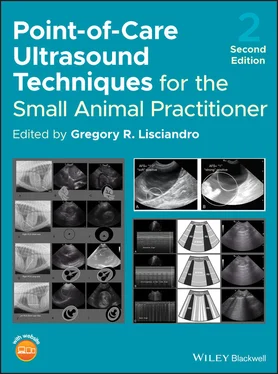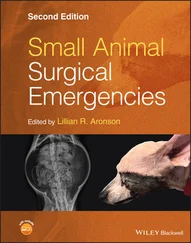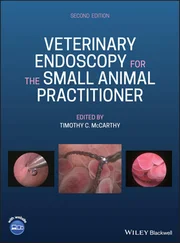1 Cover
2 Title Page
3 Copyright Page
4 Dedication Page
5 List of Contributors
6 Foreword
7 Preface
8 Acknowledgments
9 About the Companion Website
10 Section I: Basics of Ultrasound and Imaging Chapter One: POCUS: Introduction Veterinary POCUS (V‐POCUS) Defined Terminology Updates Recording Your Findings on Goal‐directed Templates Echogenicity – Whites, Grays, and Blacks How Ultrasound Behaves Relative to Tissues and Elements Ultrasound Screen Orientation Directional Terms for Orientation References Further Reading Chapter Two: POCUS: Basic Ultrasound Physics Introduction Basic Ultrasound Principles The Final Say References Further Reading Chapter Three: POCUS: Basic Ultrasound Artifacts Introduction Artifacts of Attenuation: Strong Reflectors (Bone, Stone, Air) Artifacts of Attenuation: Fluid‐Filled Structures Artifacts of Velocity or Propagation Artifacts of Multiple Echoes Pearls and Pitfalls, The Final Say References Chapter Four: POCUS: Basic Ultrasound Scanning Introduction Understanding Features of the Ultrasound Image Probe Maneuvers Cardiac Orientation Image Optimization: Using the “Big 4” Knobs of Depth, Gain, Frequency, and Focus Presets, Abdominal, Cardiac, Small Parts, etc. Alternate Imaging Tools On the Horizon Documentation of POCUS and FAST Ultrasound Examination Findings Ultrasound Machine and Probe Care Deciding on an Ultrasound Machine Setting Up an Ultrasound Program Pearls and Pitfalls, The Final Say References Chapter Five: POCUS: Top Ultrasound Mistakes During Global FAST Introduction Image Acquisition Mistakes Other Probe–Skin Contact Issues Ultrasound Machine Optimization Pearls: Trouble Shooting a Poor Image Image Interpretation Pearls, Pitfalls, and The Final Say References Further Reading
11 Section II: Abdomen Chapter Six: POCUS: AFAST – Introduction and Image Acquisition Introduction How to Perform an AFAST Exam Naming and Order of the AFAST Views AFAST Diaphragmatico‐Hepatic View AFAST Spleno‐Renal View AFAST Cysto‐Colic View AFAST Hepato‐Renal Umbilical View AFAST HR5th (SR5th) Bonus View AFAST‐Focused Spleen Recording AFAST Findings on Goal‐directed Templates Pearls and Pitfalls, The Final Say Quick Reference of Normals and Rules of Thumb References Further Reading Chapter Seven: POCUS: AFAST – Clinical Integration Introduction Calculating the Abdominal Fluid Score Major AFAST Difference Between Blunt and Penetrating Trauma Use of AFAST for Canine Anaphylaxis AFAST DH View for Pericardial Effusion AFAST Cysto‐Colic View Formula for Urinary Bladder Volume Estimation AFAST and Its Target Organ Approach Recording AFAST Findings on Goal‐directed Templates Pearls and Pitfalls, The Final Say Quick Reference of Normals and Rules of Thumb References Further Reading Chapter Eight: POCUS: Liver and Gallbladder Introduction Ultrasound Settings and Positioning How to Perform the POCUS Liver and Gallbladder Examination Ultrasonographic Findings: Normal Liver and Gallbladder Clinical Significance and Implications of Abnormal Focused Liver and Gallbladder Findings Routine Add‐on of AFAST and Abdominal Fluid Scoring System (or Global FAST) Pearls and Pitfalls, The Final Say Quick Reference of Normals and Rules of Thumb References Further Reading Chapter Nine: POCUS: Spleen Introduction Patient Positioning and Probe Selection How to Perform the POCUS Spleen Ultrasonographic Findings in a Normal Spleen Clinical Significance and Implications of Abnormal Findings Routine Add‐on of AFAST and Its Abdominal Fluid Scoring System (or Global FAST) Pearls and Pitfalls, The Final Say Quick Reference of Normals and Rules of Thumb References Chapter Ten: POCUS: Kidney Introduction Patient Positioning and Probe Selection Patient Preparation How to Perform the POCUS Kidney Ultrasonographic Findings in a Normal Kidney Routine Add‐on of AFAST and Its Abdominal Fluid Scoring System Pearls and Pitfalls, The Final Say Quick Reference of Normals and Rules of Thumb References Further Reading Chapter Eleven: POCUS: Urinary Bladder Introduction Patient Positioning and Probe Selection How to do POCUS Urinary Bladder Ultrasonographic Findings in a Normal Urinary Bladder Artifacts Associated with POCUS Urinary Bladder Clinical Significance and Implications of Abnormal POCUS Urinary Bladder Findings Routine Add‐on of AFAST and Its Abdominal Fluid Scoring System (or Global FAST) Pearls and Pitfalls, The Final Say Quick Reference of Normals and Rules of Thumb References Chapter Twelve: POCUS: Gastrointestinal Tract and Pancreas Introduction Patient Positioning and Probe Selection Scanning Technique POCUS GIT and Pancreas Findings and Their Significance Pearls, Pitfalls, The Final Say Quick Reference of Normals and Rules of Thumb References Further Reading
12 Section III: Reproductive and Pediatric Chapter Thirteen: POCUS: Reproductive – Male Introduction Reproductive Conditions of the Male The Prostate Scrotum and Testicles Pearls and Pitfalls, The Final Say Quick Reference of Normals and Rules of Thumb References Chapter Fourteen: POCUS: Reproductive – Female Introduction Reproductive Conditions of the Female Patient Positioning and Probe Selection Imaging the Normal Ovary Imaging the Normal Uterus Cystic Endometrial Hyperplasia‐Pyometra Uterine Torsion Mounting of Postoperative Recently In‐heat Spayed Females Pseudopregnancy Pregnancy Diagnosis Mammary Glands Pearls, Pitfalls, The Final Say Quick Reference of Normals and Rules of Thumb References Further Reading Chapter Fifteen: POCUS: Dystocia Introduction Dystocia Fetal Maturation: Imaging Puppies and Kittens In Utero Fetal Stress Serial POCUS Dystocia during Medical Management Pearls, Pitfalls, The Final Say Quick Reference of Normals and Rules of Thumb References Further Reading Chapter Sixteen: POCUS: Pediatrics Introduction Equipment Patient Preparation Ultrasound of the Normal Pediatric Abdomen Common Pediatric Abdominal Disorders Metabolic Conditions of the Pediatric Patient Pearls and Pitfalls, The Final Say References
13 Section IV: Thorax Chapter Seventeen: POCUS: TFAST – Introduction and Image Acquisition Introduction What Clinical Questions are Answered using TFAST TFAST and Its Five Acoustic Windows Peforming TFAST – General Set‐Up Performing the TFAST Chest Tube Site View Performing the TFAST Pericardial Views Performing the TFAST Diaphragmatico‐Hepatic View Summary of TFAST Views and Their Clinical Utility Recording TFAST Findings on Goal‐directed Templates Pearls and Pitfalls, The Final Say Quick Reference of Normals and Rules of Thumb References Chapter Eighteen: POCUS: TFAST – Clinical Integration Introduction Findings at the Chest Tube Site View Pericardial Effusion Pleural Effusion Additional Clinical Relevance of the DH View TFAST Echo Views The Global FAST Approach is Key to Averting Satisfaction of Search Error Recording TFAST Findings on Goal‐directed Templates Quick Reference of Normals and Rules of Thumb Pearls and Pitfalls, The Final Say References Chapter Nineteen: POCUS: Heart – Introduction and Image Acquisition Introduction Ultrasound Settings and Probe Preferences How to Perform a Focused Cardiac Ultrasound Pearls and Pitfalls, The Final Say Quick Reference of Normals and Rules of Thumb References Chapter Twenty: POCUS:Heart ‐ Abnormalitiesof Valves, Myocardium,and Great Vessels Introduction Valvular Heart Diseases Myocardial Diseases Cardiac Neoplasia Abnormalities of Great Vessels Cardiopulmonary Arrest Pearls and Pitfalls, The Final Say Quick Reference of Normals and Rules of Thumb References Chapter Twenty‐One: POCUS: Heart – Pericardial Effusion and Pericardiocentesis Introduction Pericardial Effusion Pericardiocentesis Pearls and Pitfalls, The Final Say Quick Reference of Normals and Rules of Thumb References Chapter Twenty‐Two: POCUS: Vet BLUE – Introduction and Image Acquisition Introduction Patient Preparation Patient Positioning Ultrasound Settings and Probe Preferences How to Do a Vet BLUE Exam Vet BLUE and Its Nine Acoustic Windows Performing the Vet BLUE Trouble Shooting Vet BLUE Six Lung Ultrasound Signs Comparison of Vet BLUE to Other Lung Ultrasound Protocols Recording Vet BLUE Findings on Goal‐directed Templates Pearls and Pitfalls, The Final Say Quick Reference of Normals and Rules of Thumb References Further Reading Chapter Twenty‐Three: POCUS: Vet BLUE
Читать дальше












